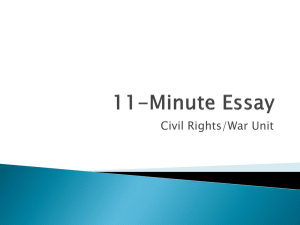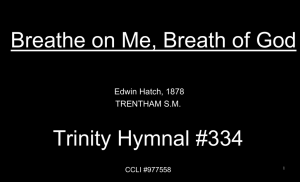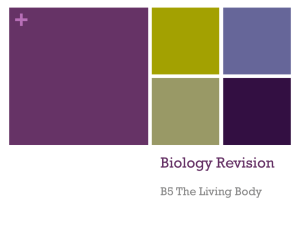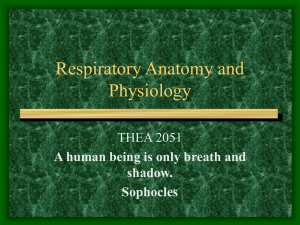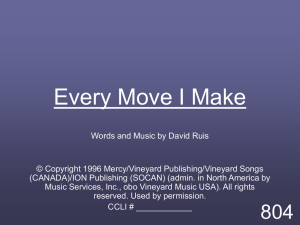RESPIRATION
advertisement
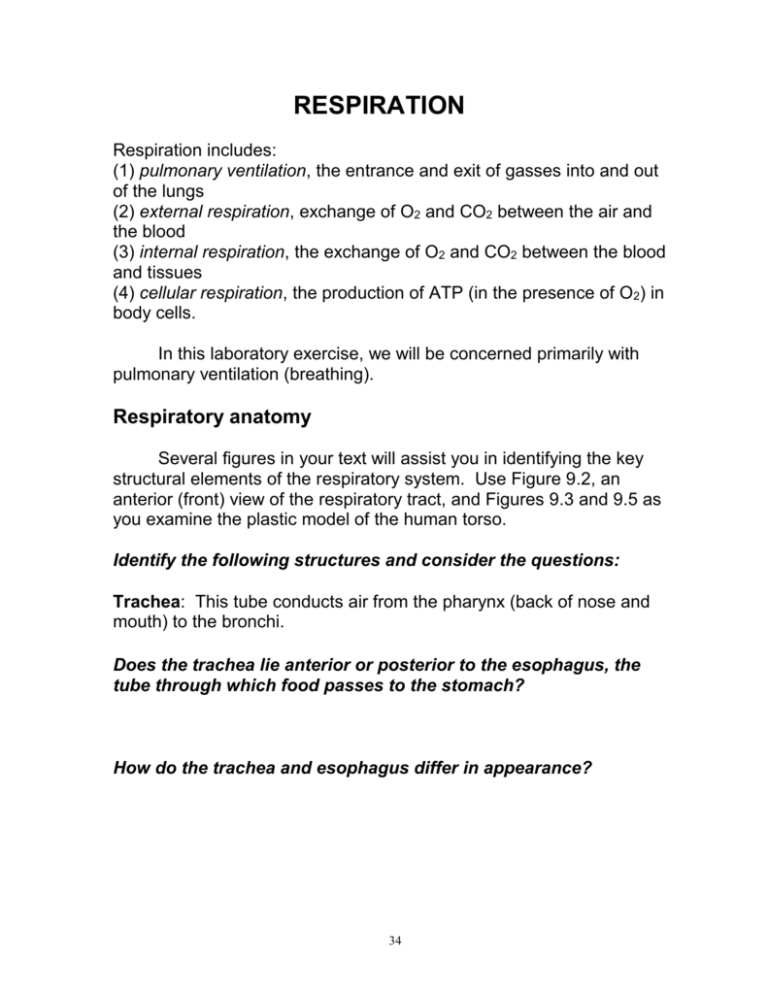
RESPIRATION Respiration includes: (1) pulmonary ventilation, the entrance and exit of gasses into and out of the lungs (2) external respiration, exchange of O2 and CO2 between the air and the blood (3) internal respiration, the exchange of O2 and CO2 between the blood and tissues (4) cellular respiration, the production of ATP (in the presence of O2) in body cells. In this laboratory exercise, we will be concerned primarily with pulmonary ventilation (breathing). Respiratory anatomy Several figures in your text will assist you in identifying the key structural elements of the respiratory system. Use Figure 9.2, an anterior (front) view of the respiratory tract, and Figures 9.3 and 9.5 as you examine the plastic model of the human torso. Identify the following structures and consider the questions: Trachea: This tube conducts air from the pharynx (back of nose and mouth) to the bronchi. Does the trachea lie anterior or posterior to the esophagus, the tube through which food passes to the stomach? How do the trachea and esophagus differ in appearance? 34 Bronchi: These major airways conduct air from the trachea to the lungs. In anatomy, right (R) and left (L) are always determined from the point of view of the subject, not the observer. With this in mind, identify the L main bronchus and R main bronchus. Bronchioles and alveoli: These are the smaller airways and the clustered, terminal gas exchange sacs. (These must be seen on the lung cast, not the plastic torso.) Lungs: These are the major gas exchange organs. Examine the L and R lungs; notice that they are segmented into lobes or major divisions. How many lobes does each lung possess? Left __________ Right __________ Are the lungs the same size? Consider the fact that the heart lies to the L in the thoracic cavity. Do the number of lobes and the relative sizes of the L and R lungs seem reasonable? Pulmonary arteries: These blood vessels conduct deoxygenated blood from the heart to the lungs. Pulmonary veins: These conduct oxygenated blood from the lungs to the heart. Diaphragm: This major muscle at the base of the thoracic cavity contracts to draw air into the lungs. When the diaphragm contracts, does it move up or down? 35 Ribs and sternum: These bones surround the thoracic cavity. (These must be seen on the skeleton model.) Where do the ribs originate? How are the ribs connected to the sternum? How does the rib cage move when you inhale? exhale? Label the following photograph: 36 An exercise in respiratory physiology Respiratory function is most easily assessed by the use of handheld or bell spirometers. Each spirometer has a meter that measures the volume of air that has been exhaled into the spirometer. The large bell spirometers measure lung volumes in liters whereas the handheld spirometers use milliliters as the units of measure. You will be reporting the volumes as liters therefore the milliliter measurements must be divided by 1,000 to obtain a liter value. In addition, the handheld spirometers operate by a small flywheel; in order to turn this flywheel you may have to exhale in a sharper, quicker fashion than normal. Record the data on the appropriate line of your lab manual. Use the instructions below to measure 4 different lung volumes Tidal Volume (TV): Inhale a volume of air into your lungs that you would with a normal average breath. Exhale into the mouthpiece of the spirometer and stop exhaling at the level that you would when taking a normal breath. Record the data in liters on the TV line. The normal TV is around 0.5 liters of air. TV______________ liters Inspiratory Reserve Volume (IRV): Inhale as much air as you can into your lungs. Exhale into the mouthpiece of the spirometer and stop exhaling at the level that you would when taking a normal breath. Record the data in liters on the IRV line. The normal IRV is around 3.1 liters of air. IRV_________________liters Expiratory Reserve Volume (ERV): Inhale a volume of air into your lungs that you would with a normal average breath. Exhale to a level that you would in a normal breath. Now exhale as much as you can into the mouthpiece of the spirometer. Record the data in liters on the ERV line. The normal ERV is around 1.2 liters of air. ERV___________liters Forced Vital Capacity (FVC): Inhale as much air as you can into your lungs. Place the mouthpiece up to you lips and exhale as much as you can into the spirometer. Record the data in liters on the FVC line. The normal ERV is around 4.8 liters of air. FVC___________liters 37 Let's see how well you've done. The graphs shown below allow you to determine the expected FVC for your age, sex, and height. Draw a line on the appropriate graph (male or female) from your age upward to your height line. From there, go across to the Y-axis to read your expected FVC. As an example, the method is illustrated for a female, age 25, height 64", yielding an expected FVC of 3.9 liters. 38 If your actual FVC is lower than the expected value, think about factors which might be reducing your respiratory performance Do you smoke? Do you get adequate/inadequate exercise? If you think about what you did in measuring your forced vital capacity (FVC), you will realize it is the sum of other three operations (IRV, TV, and ERV). Thus, the sum of IRV+TV+ERV should be close to the FVC. Check to see whether this is true. IRV + TV + ERV = __________ liters FVC = __________ liters In normal breathing, we typically use only 10-15% of our vital capacity. There is a tremendous reserve capacity. Verify that your tidal volume (normal breathing) is about 10-15% of your FVC. Tidal volume x 100% = __________ = ________ % Forced vital capacity Finally, some air always remains in the lungs to prevent their collapse. You can't force it out, so it's not measured by the FVC test. For most of us, this residual volume (RV) is about 1/3 of the FVC. Assuming this is true, calculate your RV and total lung capacity (TLC), the sum of the FVC and RV. RV = 1/3 x FVC = __________ liters TLC = FVC + RV = _________ liters 39 The Control of Breathing The objective of this exercise is to examine factors that determine the duration of a breath hold. Breathing functions to ventilate our lungs, adding oxygen (O2) and removing carbon dioxide (CO2) in the process. An individual's ventilation rate originates from neuronal "pattern generators" in the brainstem. These pattern generators receive stimulatory input from mechanoreceptors in the lungs and chest wall, and CO2 and O2 chemoreceptors in the brain and arterial blood vessels. In addition to these reflexes, breathing rate is under conscious control of higher brain centers. In humans (and all other terrestrial animals), the concentration of CO2 in the brain and blood is the primary stimulus that affects breathing rate. The CO2 concentration in expired air at the "breaking point" of a breath hold is, therefore, a very consistent index of the maximum duration of the breath hold. In other words, the duration of a breath hold is determined mainly by how long it takes to reach the body's upper CO2 set-point for each individual. Factors affecting breath holding Students should work in pairs or small groups. Each student should perform all the exercises. Work with another student who should run the stopwatch to time your breath holding. In each exercise, hold your breath for as long as possible. DO NOT time yourself (Can you see why someone else should time your breath holding?), and DO NOT engage in competitions with classmates! Allow at least 5 minutes between each exercise for recovery. DO NOT perform these exercises until you have completed the basic respiration laboratory. Remember to perform all exercises while sitting down. 1. Slowly breath in as much air as you can, then hold your breath. This point is your total lung capacity (TLC), which, as you know, is equal to your forced vital capacity (FVC) plus your residual volume (RV). Record your breath holding time (in seconds) in the Table as TLC#1. 40 2. Slowly breath in as much air as you can. Exhale normally to a relaxed volume, then hold your breath. This is your functional residual capacity (FRC), which is equal to your expiratory reserve volume (ERV) plus your RV. Record your breath holding time (in seconds) in the Table as FRC#1. 3. Repeat exercise 1 for TLC; record the result as TLC#2. 4. Repeat exercise 2 for FRC; record the result as FRC#2. 5. Hyperventilate for 30 seconds (NO LONGER; sit down before you begin this exercise!). Begin breath holding at the FRC. Record your breath holding time (in seconds) in the Table as HYPERVENT. 6. Begin holding your breath at the FRC. At the breaking point (when you cannot hold your breath any longer), exhale into a reservoir bag and immediately inhale the exhaled air. Continue to hold your breath to the next breaking point. Repeat this procedure as many times as possible until you simply cannot hold your breath after rebreathing the air. Record your breath holding times (in seconds) in the Table as REBREATHING. Add these times together to get your total breath holding duration for this exercise and record this value in the Table. 7. Begin holding your breath at the FRC and hold your breath while squeezing a handgrip. Record the breath holding time (in seconds) in the Table as HAND EXERCISE. 8. Repeat exercise 1 for TLC; record the result as TLC#3. 9. Repeat exercise 2 for FRC; record the result as FRC#3. 41 RESULT TABLE Exercise Breath holding duration (secs) TLC#1 __________________________ FRC#1 __________________________ TLC#2 __________________________ FRC#2 __________________________ HYPERVENT __________________________ REBREATHING __________________________ HAND EXERCISE __________________________ TLC#3 __________________________ FRC#3 __________________________ Interpretation of results 1. Does the starting volume of air in the lungs affect the breath holding duration? Explain your answer based on your results and those of your group mates with the TLC and FRC exercises. 2. Were the second and third TLC and FRC breath hold times longer or shorter than the first trials? Explain any difference. 42 3. Why does hyperventilation increase breath holding time? What is the stimulus that makes us stop the breath hold? 4. Did exhaling into the bag increase or decrease the total breath hold duration? Explain your answer. 5. Why was there a difference in the breath hold duration when you started holding your breath at FRC but squeezed a handgrip? Compare the time of this exercise with the second and third FRC trials. Internet Resources The “Virtual Hospital” has a tutorial on lung anatomy; check http://www.vh.org/adult/provider/radiology/LungAnatomy/LungAnatomy. html. To learn about more about the lungs and lung diseases, connect to the American Lung Association site at http://www.lungusa.org. A general review of respiratory physiology and the specific problems associated with scuba diving can be found at http://www.mtsinai.org/pulmonary/books/scuba/contents.htm. 43
